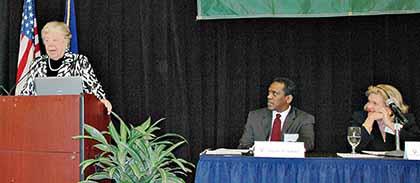By Howard Koplowitz
Proponents of economic development spoke about the numerous projects to revitalize the borough during a breakfast Friday at Queens College.
Claire Shulman, former borough president and chief executive officer as well as president of the Flushing, Willets Point, Corona Development Corp., told the attendees about the ongoing transformation of downtown Flushing and Willets Point.
“Downtown Flushing has a lot of wonderful people and not good infrastructure,” Shulman said at the breakfast, sponsored by the Queens borough president’s office, Queens Chamber of Commerce, Queens Courier, Queens Economic Development Corp., Farrel Fritz P.C., PricewaterhouseCoopers and TD Bank.
She said the No. 7 train is overcrowded and the Long Island Rail Road’s Flushing-Main Street stop “is almost inaccessible.”
But Shulman said there are plans to put two elevators in each direction of the LIRR stop and that the parking lot on the Port Washington side will soon be home to affordable housing.
“It is a great project,” she said. “This project is very important for the future of Flushing.”
She said an area near the Flushing River is in the process of being rezoned to allow for more open space.
Shulman noted that Community Board 7 approved of the change, which she said will be compatible with the redevelopment of Willets Point and provide a pedestrian bridge to the Iron Triangle.
Shulman also spoke of plans to improve pedestrian safety by creating pedestrian islands on College Point Boulevard between 32nd and Fowler avenues.
“It will be lovely and it will really enhance the whole area,” she said.
She said Flushing Commons, the $850 million mixed-use project bounded by Union and 139th streets and 37th and 39th avenues, is “sort of ready to put a shovel in the ground.”
“We are working very hard to satisfy the needs of the people of downtown Flushing,” Shulman said. “Flushing was not doing so well until the Asians came. They stabilized that area of Queens. They have made our borough that much stronger.”
Carlisle Towery, president of the Greater Jamaica Development Corp., updated attendees on the progress in revitalizing downtown Jamaica.
Towery said two important projects were the reuse of the Dutch Reformed Church, which was turned into a performing arts center, and transforming a chapel on the York College campus into another performing arts space.
Other new buildings in the area include the Social Security building and the U.S. Food and Drug Administration building on York’s campus, Towery said.
But he also spoke of hardship in the area, pointing out that there were once 10,000 light industrial jobs in downtown Jamaica which have dwindled to 6,000 over the last 20 years.
Towery also spoke about the shuttering of the Wonderbread factory and how Jamaica Hospital is “suffering” due to the closure of Mary Immaculate Hospital.
But Towery said things are looking up for the neighborhood.
“Jamaica’s potential is our passion,” he said. “We see more potentials than we see progress.”
He said there are “several likely hotels” to be build in the neighborhood and $100 million has been earmarked to create a pedestrian arcade with shops by the LIRR underpass.
“We’ve made really good, strong progress,” Towery said.
Gayle Baron, president of the Long Island City Business Development Corp., said the western Queens area has been ripe for development after a 2001 zoning change.
She said that this year thousands of new apartments and retail shops as well as new business and hotels will be constructed or completed.
Among the buildings is the 21-story Gotham Center, which replaces the old municipal parking garage in the neighborhood.
Baron said 1,100 jobs are coming to the area around Queens Plaza North and noted that the neighborhood will soon be home to the 650-room, 35-story Toyoko Inn, the largest hotel in the city outside of Manhattan.
Ted Renz, executive director of the Ridgewood LDC/Myrtle Avenue BID, said the city’s $16 million investment in 2008 at Myrtle and Wyckoff avenues — where the M and L subway lines stop as well as six bus lines — created new lighting and infrastructure.
“We are hopeful that this area will be ripe” for private investment, he said.
Renz said residential condos are being built off Myrtle Avenue, including The Times Building, where 19 units have been created.
Kevin Alexander, executive director of the Rockaway Revitalization & Development Corp., described how Arverne by the Sea is transforming the peninsula.
“The impact of Arverne by the Sea hasn’t been fully felt,” he said.
Reach reporter Howard Koplowitz by e-mail at hkoplowitz@cnglocal.com or by phone at 718-260-4573.

































